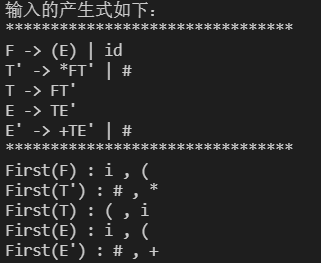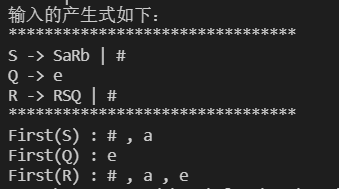您好,登錄后才能下訂單哦!
您好,登錄后才能下訂單哦!
這篇文章主要介紹“C++編譯原理之怎么求解First集合”,在日常操作中,相信很多人在C++編譯原理之怎么求解First集合問題上存在疑惑,小編查閱了各式資料,整理出簡單好用的操作方法,希望對大家解答”C++編譯原理之怎么求解First集合”的疑惑有所幫助!接下來,請跟著小編一起來學習吧!
1、上機要求
2、原理
3、一點思路及優化
4、代碼
4.1 lan.txt文件內容
4.2 lan.txt文件內容
目的:熟練掌握自上而下的語法分析方法,并能用程序實現。
要求:
例如,使用的文法如下:
編寫First函數,實現其求解過程。
E -> TE'
E' -> +TE' | #
T -> FT'
T' -> *FT' | #
F -> (E) | id
end
提示:
非終結符為 大寫字母;或 后面帶'的大寫字母
終結符為 小寫字母和符號(+、*)
推導符號→為或->
用end結束文法。
不針對特定文法,編寫求first函數。
A -> a, 則將 a 加入 First(A)中A -> Y1Y2···Yn
將 First(Y1) 除空串外的字符加入到First(A)中,若 1 =< i < n - 1,Y1,Y2, Yi中均含有空串,則將First(Yi + 1)加入到First(A)中,若Y1,Y2,···,Yn都有空串,則將空串加入到First(A)中
First(a) = {a}
將輸入格式化(掃描輸入)
將產生式轉換為哈希map:
對任一產生式: A -> body_1 | body_2 | ··· | body_n,
將 A 作為map的 key,
map的value為一個string類的向量(vector<string> ),
將 body_1,body_2,···,body_n 都加入value中。
求解First(str)
特殊情況處理,str為空或str不在產生式的key中,返回空;str的首個字符是終結符,返回首個字符構成的集合。
一般情況,獲取str推導產生的產生體集bodys(其中的每個產生體為body),遍歷產生體集合求解First集
針對空串,我們加入標記hasBlank = true,往下遍歷body的字符
body的首個字符為終結符,直接將該字符加入first集,記hasBlank = false以便遍歷下一body(如果有的話)。
body的首個字符為非終結符,遞歸求解該非終結符first集,記為temp,同時將空串標記記為false,將temp的中除空串外的字符加入first集;若temp中有空串,記空串標記為true,繼續遍歷當前body的字符,理解上可以將body后面的字符串視為一個新的body繼續進行求解步驟。
body的字符遍歷結束后若空串標記hasBlank仍然為true,則將空串加入first集。
優化:遞歸求解的中間結果可以放在全局哈希First(或者換個名字避免沖突)中,避免重復的迭代(本代碼沒實現,下次一定)。
/**
* @brief Function for generating set of First(a)
* @author 立秋小豬
* @time: 2021/10/13
* @notice: 要求產生體句型不得有空格
* 左遞歸的產生體中必須有空串(必須能夠終結)
* char '#' act as varepsilon
* **/
#include <iostream>
#include <unordered_map>
#include <vector>
#include <string>
#include <fstream>
#include <unordered_set>
using namespace std;
unordered_map<string, vector<string>> P; //產生式P的集合
void scan(){
//scan函數實現從文件掃描文法,將對應的產生式加入到映射P中
fstream fs;
string input;
fs.open("lan.txt");
if(!fs.is_open()){ // 文件打開失敗
cout << "Error: Could not open the file" << endl;
exit(-1);
}
fs >> input;
while(input != "end"){
string VN = input; // 產生式的非終結符
fs >> input; //跳過推導符號
if (input != "->" && input != "→"){
cout << "Error: undefined symbol [" << input << "]" << endl;
exit(-2);
}
fs >> input; //產生體拆開后加入到set集合中,默認推導符號后必有一個產生體
P[VN].emplace_back(input);
while( fs >> input && input == "|"){
fs >> input;
P[VN].emplace_back(input);
}
}
}
// void generate(){
// }
unordered_set<char> First(const string& str){
// 終結符以及空串情況下, whether has the VN or not
if(str == "" || str == "#" || P.find(str) == P.end())
return {};
if(!(str[0] >= 'A' && str[0] <= 'Z'))
return {str[0]};
vector<string> bodys = P[str]; // str -> bodys
unordered_set<char> res = {};
for(auto &s: bodys){
bool hasBlank = true;//是否含有空串,是否繼續讀產生體
for (int i = 0; i < s.size() && hasBlank; ++i){
if(s[i] >= 'A' && s[i] <= 'Z'){//是否為終結符
unordered_set<char> temp = {};//遞歸的臨時集
string next;
if(i < s.size() - 1 && s[i + 1] == '\''){ // 大寫字母 + ' 的非終結符
next = s.substr(i, 2);
++i;
}else{ //僅僅是大寫字母的終結符
next = s[i];
}
if(next != str){ //避免無限遞歸,默認自身是含有空串(hasBlank為True)
temp = First(next); //遞歸求解
hasBlank = false; //先默認temp中沒有空串
for(auto &c : temp)
if(c == '#')
hasBlank = true;//temp中發現了空串
else
res.emplace(c);
}
}else{
res.emplace(s[i]);
hasBlank = false;//默認連接的終結符不為空,故此終結符后不會再有新元素加入First集
}
}
if(hasBlank) //產生體中所有非終結符都包含空串,則將空串加入first集中
res.emplace('#');
}
return res;
}
int main(){
// unordered_map<string, vector<char>> First; //First集合
scan();
cout << "輸入的產生式如下:\n"
<< "********************************\n";
for(auto &[vn, bodys]: P){
cout << vn << " -> " << bodys[0];
for (int i = 1; i < bodys.size(); ++i)
cout << " | " << bodys[i];
cout << endl;
}
cout << "********************************\n";
for(auto &[vn,_]: P){
unordered_set<char> f = First(vn);
cout << "First(" << vn << ") : ";
auto iter = f.begin();
if(iter != f.end()){
cout << *iter;
while(++iter != f.end()){
cout << " , " << *iter;
}
}
cout << endl;
}
return 0;
}E -> TE' E' -> +TE' | # T -> FT' T' -> *FT' | # F -> (E) | id end
運行結果

S -> SaRb | # R -> RSQ | # Q -> e end
運行結果

到此,關于“C++編譯原理之怎么求解First集合”的學習就結束了,希望能夠解決大家的疑惑。理論與實踐的搭配能更好的幫助大家學習,快去試試吧!若想繼續學習更多相關知識,請繼續關注億速云網站,小編會繼續努力為大家帶來更多實用的文章!
免責聲明:本站發布的內容(圖片、視頻和文字)以原創、轉載和分享為主,文章觀點不代表本網站立場,如果涉及侵權請聯系站長郵箱:is@yisu.com進行舉報,并提供相關證據,一經查實,將立刻刪除涉嫌侵權內容。